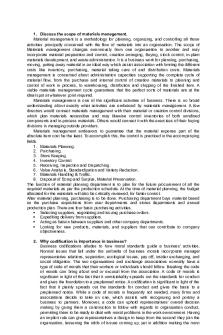Discuss the contribution of Pavlov’s research into our understanding of human behaviour PDF

| Title | Discuss the contribution of Pavlov’s research into our understanding of human behaviour |
|---|---|
| Course | Social Psychology |
| Institution | The University of Warwick |
| Pages | 1 |
| File Size | 43 KB |
| File Type | |
| Total Downloads | 53 |
| Total Views | 135 |
Summary
Download Discuss the contribution of Pavlov’s research into our understanding of human behaviour PDF
Description
NOOR
Discuss the contribution of Pavlov’s research into our understanding of human behaviour (12)
Classical conditioning is learning through association and was first demonstrated by Ivan Pavlov. Pavlov showed that dogs could be conditioned to salivate at the sound of a bell if that sound was repeatedly presented at the same time that they were given food. Pavlov’s research contributed to our understanding of human behaviour as many of the experiments carried out were on animals. He helped psychologists to understand that humans are different cognitively and psychologically; humans have different social norms and moral values from the environment therefore we may behave differently from animals and the laws and principles derived from this experiment may apply to animals more than humans. Additionally, Pavlov’s research helped us understand that learning is based on association. Classical conditioning emphasises the importance of learning from the environment and supports nature over nurture. A strength of it is that it is scientific and based on evidence carried out in controlled experiments, therefore the behaviour observed is highly controlled with no effects from extraneous variables.
The principles of conditioning have been applied to a broad range of real-world behaviours and problems. For instance, classical conditioning has been applied to the treatment of phobias. Treatments such as these have the advantage of requiring less effort from a patient because the patient doesn’t have to think about their problem (as they do in therapy). Behaviourists argue that phobias are learned when a neutral object is associated with a stimulus that already causes fear. Therefore, the theory of classical conditioning being used in everyday life suggests that it has high ecological validity. The research also provides theories around studies such as the Little Albert Experiment and gives us an explanation for why people have phobias. Ivan Pavlov showed that classical conditioning applied to animals but his research was also able to make way for experiments such as Watson and Rayner’s (1920) that demonstrated that is applied to humans too. This research showed that classical conditioning could be used to create a phobia. They had successfully conditioned Albert to fear the white rat and that his fear response generalised to other white, furry things and transferred to other situations. Overall this research concluded it is possible to produce a fear response in a human using the process of conditioning....
Similar Free PDFs

The Behaviour of Firms
- 6 Pages

BPS Code of Human Research Ethics
- 48 Pages
Popular Institutions
- Tinajero National High School - Annex
- Politeknik Caltex Riau
- Yokohama City University
- SGT University
- University of Al-Qadisiyah
- Divine Word College of Vigan
- Techniek College Rotterdam
- Universidade de Santiago
- Universiti Teknologi MARA Cawangan Johor Kampus Pasir Gudang
- Poltekkes Kemenkes Yogyakarta
- Baguio City National High School
- Colegio san marcos
- preparatoria uno
- Centro de Bachillerato Tecnológico Industrial y de Servicios No. 107
- Dalian Maritime University
- Quang Trung Secondary School
- Colegio Tecnológico en Informática
- Corporación Regional de Educación Superior
- Grupo CEDVA
- Dar Al Uloom University
- Centro de Estudios Preuniversitarios de la Universidad Nacional de Ingeniería
- 上智大学
- Aakash International School, Nuna Majara
- San Felipe Neri Catholic School
- Kang Chiao International School - New Taipei City
- Misamis Occidental National High School
- Institución Educativa Escuela Normal Juan Ladrilleros
- Kolehiyo ng Pantukan
- Batanes State College
- Instituto Continental
- Sekolah Menengah Kejuruan Kesehatan Kaltara (Tarakan)
- Colegio de La Inmaculada Concepcion - Cebu













